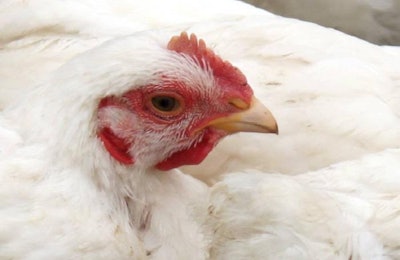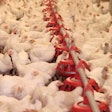
Taiwan and Bulgaria are the only countries to have officially recorded new outbreaks of avian influenza in poultry over the past week. Local media and other sources are also reporting further cases in Poland and Vietnam. The disease situation in Hungary and Ukraine appears to have been resolved.
Taiwan’s battle against avian flu in poultry — ongoing for more than five years — shows little sign of abating. The official animal health agency has reported cases involving three different virus types to the World Organisation for Animal Health (OIE) over the past week.
There have been two new outbreaks of highly pathogenic avian influenza (HPAI) linked to the H5N2 virus subtype, according to the Council of Agriculture’s official latest report. Suspicious signs were observed in 25 birds out of a group of around 300 native chickens at a slaughterhouse in the Hunei district of Kaohsiung city earlier this month. Around 10 days later, more than 9,000 native chickens died out of a flock of more than 39,000 birds at a farm in Xinpi, which is in Pingtung County.
Presence of the H5N2 HPAI virus was confirmed at both locations. At the slaughterhouse, all the carcasses of the infected batch were destroyed, and the facility was thoroughly cleaned and disinfected. The farm of origin will be checked. All remaining birds at the infected farm were culled and destroyed, and the premises were subjected to hygiene procedures. Other poultry farms within three kilometers of the outbreaks will be subjected to intensive monitoring for the following three months.
These latest cases bring Taiwan’s total outbreaks linked to this virus so far this year to 22, with more than 244,000 poultry lost due to mortality or culling.
The Council of Agriculture has also recorded with the OIE four new outbreaks of HPAI linked to the H5N5 virus variant. In Taipei and Kaohsiung, outbreaks were confirmed after native chickens showed typical symptoms at slaughterhouses. A group of 40 geese sampled in Tainan city tested positive for this virus. Its presence was also detected at a farm with around 11,000 native chickens in Yunlin County after more than 300 of the birds there died.
These latest outbreaks led to the direct loss of more than 12,000 poultry through mortality or culling from this virus type. They also bring to 12 the number of HPAI outbreaks involving the H5N5 virus since September of 2019, when this variant was first detected in Taiwan.
Early in February, a low-pathogenic variant of the H5N2 virus was detected at a farm in Puzi city, which is in Chiayi County. An estimated 1,500 native chickens died, and the remaining 12,000 have been destroyed. Last reported in January, this virus has been found in Taiwan periodically since 2015.
Two new outbreaks in Bulgaria
In early March, the H5N8 HPAI virus was detected at two more farms in the region of Plovdiv, according to the latest report to the OIE from Bulgaria’s agriculture ministry. Around 40 birds showed signs of the disease, and a total of 8,620 were culled.
Based on reports sent to the OIE, these bring the country’s total outbreaks since mid-February to five, with more than 91,000 poultry lost to the disease through mortality or culling.
These latest cases were identified in mulard ducks as the result of intensive surveillance in the area surrounding the earlier outbreaks, according to the Italian health authority and research organization for animal health and food safety (IZSVe).
Poland reports further outbreaks
According to the IZSVe, there have been a total of 30 confirmed outbreaks of HPAI in domestic poultry in Poland since December,31, 2019. In all cases, the H5N8 virus subtype has been detected and reported by the Polish veterinary authorities. More than 474,000 poultry have been involved in these outbreaks.
Since the latest report to the OIE around two weeks ago, the disease has been confirmed in three commercial ducks flocks — two in the province of Lodz, and one in Greater Poland — and in a mixed flock of around 4,400 birds in Silesia. Total numbers of poultry involved in these outbreaks is 54,670.
Up to February 22, Poland’s agriculture ministry had confirmed 24 outbreaks, and the loss of almost 359,000 poultry to the OIE.
New cases at Vietnam duck farm
As a result of an HPAI outbreak, hundreds of poultry have recently been culled in the province of Ha Nam in the north of the country, reports Vietnam News. At one farm, 770 ducks were culled to halt the spread of the H5N6 HPAI virus. Movements of poultry in the area have been banned, nearby poultry are being vaccinated, and the area is undergoing disinfection.
With the ongoing African swine fever crisis in Vietnam, many former pig farmers have switched to poultry farming, according to the report. The number of poultry in Ha Nam is now 6.8 million — 15% more than in 2018.
In a previous report from the same source, the country’s deputy agriculture minister blamed the recent spread of HPAI on poultry owners neglecting the vaccination of their birds. On larger farms, poultry are better protected from HPAI because of the high vaccination rate, he said.
During February, Vietnam’s agriculture ministry reported to the OIE the return of both the H5N1 and H5N6 HPAI virus subtypes. While the five confirmed H5N1 outbreaks have been in village flocks in southern provinces, the H5N6 virus has so far only been detected in the north of the country. If confirmed, this latest outbreak brings the number of HPAI-infected northern provinces to nine.
So far this year, Vietnam has culled more than 137,000 poultry in an attempt to control HPAI, reports The Jakarta Post, citing Vietnamese government data. It reports 38 outbreaks linked to the H5N6 virus, and five involving H5N1 in 13 of the country’s 63 provinces so far this year.
North Korea boosts avian flu controls
Following the latest reported HPAI outbreak in China, North Korea’s leader Kim Jong-un has ordered the government to strengthen the country’s disease control measures.
At an early morning meeting, the President ordered his officials to concentrate their efforts on keeping the disease out of key areas where outbreaks are most likely, reported Daily NK. Among the new measures will be a doubling of the number of personnel working to prevent the disease in these designated areas.
Last month, the military was deployed to chase wild birds away from their breeding grounds in North Korea, according to the same source.
HPAI resolved in Hungary, Ukraine
Hungary’s agriculture ministry has reported to the OIE that the HPAI situation has been “resolved.”
This declaration follows a total of four outbreaks linked to the H5N8 virus variant at commercial farms in two different parts of the country during January this year. The virus was detected in fattening turkeys at three farms in Komarom-Esztergom in the north of the country, and in a large duck flock in the eastern county of Hajdu-Bihar.
HPAI-related quarantine measures have been lifted in Ukraine, according to the latest report from the animal health agency to the OIE. This declaration follows a single outbreak linked to an H5 virus at a large farm in Vinnitsa in mid-January.
View our continuing coverage of the global avian influenza situation.

















